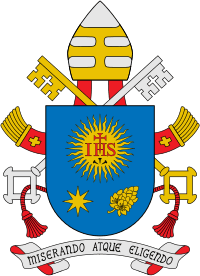Spikenard
Spikenard, also called nard, nardin, and muskroot, is a class of aromatic amber-colored essential oil derived from Nardostachys jatamansi, a flowering plant of the valerian family which grows in the Himalayas of Nepal, China, and India. The oil has been used over centuries as a perfume, a traditional medicine, or in religious ceremonies across a wide territory from India to Europe.

Catholic Church iconography uses spikenard to represent Saint Joseph. With this meaning, Pope Francis has included the spikenard in his coat of arms.
Plant sources
_02.jpg)
Nardostachys jatamansi is a flowering plant of the valerian family that grows in the Himalayas of Nepal, China, and India. The plant grows to about 1 meter (3 ft) in height and has pink, bell-shaped flowers. It is found at an altitude of about 3,000 to 5,000 m (9,800 to 16,400 ft). Rhizomes (underground stems) can be crushed and distilled into an intensely aromatic amber-colored essential oil with thick consistency. Nard oil is used as a perfume, an incense, and an herbal medicine.[1]
Etymology

The name "nard" is derived from Latin nardus, from Greek νάρδος. This word may ultimately derive either from Sanskrit naladam (Indian spikenard), or from Naarda, an ancient Assyrian city (possibly the modern town of Dohuk, Iraq).[2]
Ancient uses
In ancient Rome, nardus was used to flavor wine, and occurs frequently in the recipes of Apicius.[3][4] During the early Roman empire, nardus was the main ingredient of a perfume (unguentum nardinum),[3] and Pliny's Natural History lists twelve "species" of nardus, identifiable to varying degrees of assurance, including Lavandula stoechas and tuberous valerian as well as spikenard (Nardostachys jatamansi).
Religion
In the Hispanic iconographic tradition of the Catholic Church, the spikenard is used to represent Saint Joseph.[5] The Vatican has said that the coat of arms of Pope Francis includes the spikenard in reference to Saint Joseph.[5][6][7]
Nard (Italian nardo) is also mentioned in the Inferno of Dante Alighieri's Divine Comedy:
erba né biado in sua vita non pasce, |
References
- Dalby, Andrew (2000), Dangerous Tastes: the story of spices, London: British Museum Press, ISBN 978-0-7141-2720-0 (US ISBN 0-520-22789-1) pp. 83–88
- The origin of most of these quotes comes from Dr. William Thomas Fernie, in his book "Herbal Simples" (Bristol Pub., second edition, 1897), page 298: 'By the Greeks the name Nardus is given to Lavender, from Naarda, a city of Syria near the Euphrates, and many persons call the plant "Nard." St. Mark mentions this as Spikenard, a thing of great value. In Pliny's time, blossoms of the Nardus sold for a hundred Roman denarii (or L.3 2s. 6d.) the pound. This Lavender or Nardus was called Asarum by the Romans, because it was not used in garlands or chaplets. It was formerly believed that the asp, a dangerous kind of viper, made Lavender its habitual place of abode, so that the plant had to be approached with great caution.'
- ""Nardinus"". Charlton T. Lewis, Charles Short, A Latin Dictionary at perseus.tufts.edu.
- "Apicius; De Re Coquinaria". Nemeton. Retrieved 5 November 2011.
- "Lo Stemma di Papa Francesco". L'Osservatore Romano (Vatican website). Retrieved 18 March 2013. (In Italian: il fiore di nardo indica San Giuseppe...Nella tradizione iconografica ispanica, infatti, San Giuseppe è raffigurato con un ramo di nardo in mano, translates as "the spikenard represents Saint Joseph...In the Hispanic iconographic tradition, in fact, St Joseph is depicted with a branch of spikenard in his hand").
- "Vatican releases Pope Francis' coat of arms, motto and ring". The Telegraph. 18 March 2013. Retrieved 18 March 2013.
- "Pope stresses simplicity, ecumenism in inaugural Mass plans". National Catholic Reporter. 18 March 2013. Retrieved 18 March 2013.
- tr. H. F. Cary) (Dante Alighieri (1845). The Vision, Or, Hell, Purgatory and Paradise of Dante Alighieri. D. Appleton & Company. p. 171.)
Further reading
- Dalby, Andrew, "Spikenard" in Alan Davidson, The Oxford Companion to Food, 2nd ed. by Tom Jaine (Oxford: Oxford University Press, 2006. ISBN 0-19-280681-5).